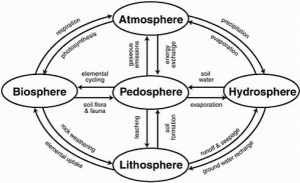The Gaia hypothesis was first proposed by James Lovelock in the 1970’s and continues to be broadly skeptically received by the scientific community. However, it awakens inspiring, visionary implications.
It posits that the Earth is a self-regulating complex system involving the biosphere, the atmosphere, the hydrosphere and the pedosphere, tightly coupled as an evolving system. The hypothesis contends that this system as a whole, called Gaia, seeks a physical and chemical environment optimal for contemporary life. (Figure 1.)
Many scientists criticize the Gaia approach taken by Lovelock as teleological and some of its key theories cannot be proven scientifically. However, the hypothesis has spawn extensive and promising research. Responding to this critique in 1990, Lovelock stated, “Nowhere in our writings do we express the idea that planetary self-regulation is purposeful, or involves foresight or planning by the biota”.
The scientific objections are mainly based upon our “Modern” standard acceptance of the definition of Reality-that which is known only by our logic & by scientific rationalism, whose 17th c. philosophic source was Descartes. He, proposed, the idea that there are two sorts of substances in the world: thinking things like us and extended things that can be measured, like tables, chairs, nature and indeed the entire fabric of space and time. Unfortunately, this material determinism mindset has separated humanity & nature, dehumanized the individual & caused the global social & earth crisis in which we exist today. A more holistic view of Reality finds the Gaia hypothesis more acceptable.
Gaia has also fostered more sympathetic research and there is a movement today that articulates the need for an ecological approach founded on spiritual awareness, called “Spiritual Ecology” that is an emerging field in religion, Sufism, conservation, and academia that proposes that there is a spiritual facet to all issues related to conservation, environmentalism, and earth stewardship.
I propose to consider instead something new. Something more holistic, more complete which also includes human intuition and metaphysics, like that proposed by Heidegger, who turned Descartes famous dictum upside down, by saying “I am, therefore, I think”.
The implications of Heidegger’s observations are that If the human being is really being-in-the-world, then this entails that the world itself is part of the fundamental constitution of what it means to be human. Quoting Heidegger: “That is to say, I am not a free-floating self or ego facing a world of objects that stands over against me”. Rather, for Heidegger, I am my world. The world is part and parcel of my being, of the fabric of my existence. I am completely fascinated and absorbed by my world, not cut off from it in some sort of “mind” or what Heidegger calls “the cabinet of consciousness”. The world is full of handy things that hang together as a whole and which are meaningful to me. In even more basic terms, the world is a whole load of stuff that is related together, what Heidegger calls “Environment”.
Here, it may be worth recalling the theory of Wahdat al Wujud- The Unity of Existence by the 13th c. Andalusian philosopher Ibn Arabi, who said: “The World and I are One!”

Figure 1. The Earth is a self-regulating complex system involving the biosphere, the atmosphere, the hydrosphere, lithosphere and the pedosphere, tightly coupled as an evolving system. The hypothesis contends that this system as a whole, called Gaia, seeks a physical and chemical environment optimal for contemporary life, including human beings.

